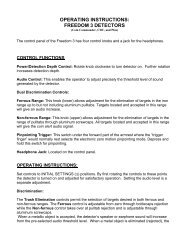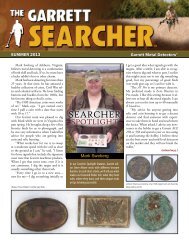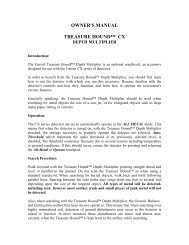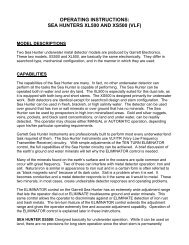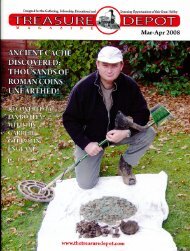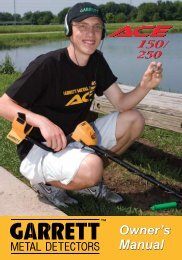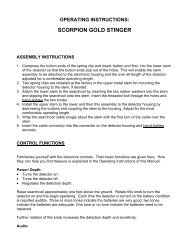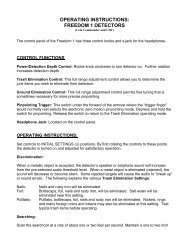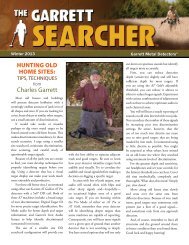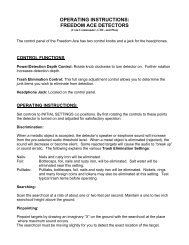Responsible Relic Recovery Of Cherokee War Artifacts - Garrett
Responsible Relic Recovery Of Cherokee War Artifacts - Garrett
Responsible Relic Recovery Of Cherokee War Artifacts - Garrett
Create successful ePaper yourself
Turn your PDF publications into a flip-book with our unique Google optimized e-Paper software.
plus Vaughan <strong>Garrett</strong> and Brian McKenzie to document any<br />
discoveries with video and still photography. We brought<br />
along a number of <strong>Garrett</strong>’s most advanced metal detectors:<br />
the GTI 2500, GTI 1500, GTP 1350 and an ACE 250. We worked<br />
into the late afternoon, doing reconnaissance scanning of<br />
the areas surrounding a field containing Bowles’ marker.<br />
We also ventured into the deep woods, working through<br />
deep creek beds and following them out toward the Neches<br />
River bottomlands. By the end of a full day’s hunt, we had<br />
collected shotgun shells, modern bullets and various rural<br />
farmland metallic junk. Joe even dug up some World <strong>War</strong><br />
I-era blunts, bullets somewhat similar to those used decades<br />
before during the Civil <strong>War</strong>.<br />
The artifacts we sought from the 1830s period had proven<br />
to be elusive. Several weeks later, I returned to search the<br />
AICS property again with Joe, Robert and Keith Wills. We<br />
searched over some of the likely areas near the creek and<br />
all around the large hilltop where a Delaware Indian village<br />
was said to have been. Once again, we found modern bullets,<br />
some coins, an old watch and miscellaneous metallic junk.<br />
The four of us then made a reconnaissance line and scouted<br />
with our detectors back toward the road, moving up another<br />
small hill and into the forest again before finally reaching the<br />
property’s barbed wire fence line.<br />
Keith and I agreed that we must be searching on the tail<br />
end of the battlefield. Obviously, there were some artifacts in<br />
this area at one time but even modern souvenir hunters and<br />
previous timber-cutting operations would not have removed<br />
all traces of such a heavily-contested battle. The next step<br />
was to research the earliest information on the Neches<br />
battle more thoroughly while attempting to gain permission<br />
from the adjacent landowners to conduct a survey on their<br />
property.<br />
(Left) In his "Battle of the Neches"<br />
painting from 1967, artist Donald M.<br />
Yena captured the closing moments of<br />
the 1839 battle. Chief Bowles (below),<br />
with his ceremonial sword upraised,<br />
is shot in the back after his horse has<br />
been crippled with numerous rifle ball<br />
shots. Painting used by permission of<br />
Frank Horlock and Michael Krueger.<br />
Bowles illustration courtesy of Texas<br />
State Library & Archives Commission.<br />
Since our first efforts to recover relics on the AICS land<br />
had been fruitless, I decided to forget about where the<br />
Bowles marker stands and where the battle was assumed<br />
to have been concentrated. It was time to dig back into the<br />
earliest accounts of the battle and to visit with others who<br />
might have some useful information.<br />
A 1920s article by Dr. Albert Woldert became my<br />
primary focus, particularly several detailed maps based on<br />
his research. The spot where he had labeled Chief Bowles<br />
to have died was on the opposite side of a particular<br />
creek than where I had expected it to be shown. Modern<br />
graphics programs allowed me to scan in this map and<br />
overlay it on a satellite image of the area and on a scanned<br />
page from a detailed Texas road map of the county. The<br />
new composited picture convinced me that we would<br />
find the main battle area somewhat south of the area<br />
owned by AICS. This map work convinced me that the<br />
old Delaware village was not exactly on the hilltop where<br />
the tribal stones have been placed. Could there be another<br />
significant hilltop within 300 yards to the southwest?<br />
Fortunately, landowners Thurman and Alice Jett<br />
were open to this historical quest and it was with great<br />
excitement that I led another group of detectorists to hunt<br />
their land in early 2009. Mr. Jett even mentioned that his<br />
family had plowed up bits of old pottery for years and<br />
had often found arrowheads on their property. It was all<br />
coming together like lost pieces to a puzzle. As our <strong>Garrett</strong><br />
search team first drove onto the property to meet the Jetts,<br />
there was the hill I had hoped to find! It rose up out of the<br />
heavy timber from the south, reached its peak right where<br />
the home sits and then fell off sharply on the north and<br />
east sides. Behind the Jett’s home is a steep hill that opens<br />
onto a vast farmland prairie containing a small creek.



